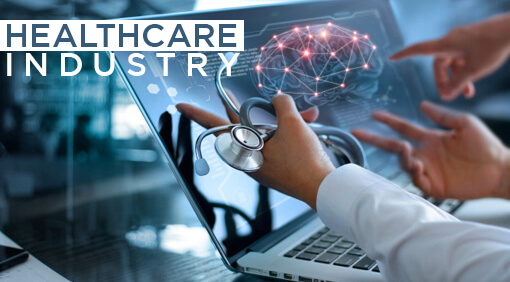The need for remote healthcare solutions has become increasingly apparent as the world continues to undergo digital healthcare transformation. Telehealth APIs are emerging as a powerful tool to facilitate access to medical services and treatment from afar.
These tools provide unparalleled convenience and can help bridge gaps in patient care that have been exposed during this time of crisis. With telehealth APIs, doctors can consult with patients remotely while providing vital medical information securely over digital networks.
Furthermore, remote healthcare solutions enable healthcare providers to develop innovative applications quickly. These apps are tailored specifically to their practice or facility’s needs, allowing them to offer better quality service more efficiently than ever before. The use of telehealth APIs is revolutionizing how we think about healthcare delivery and promises excellent benefits both now and in the future.
Do You Know?
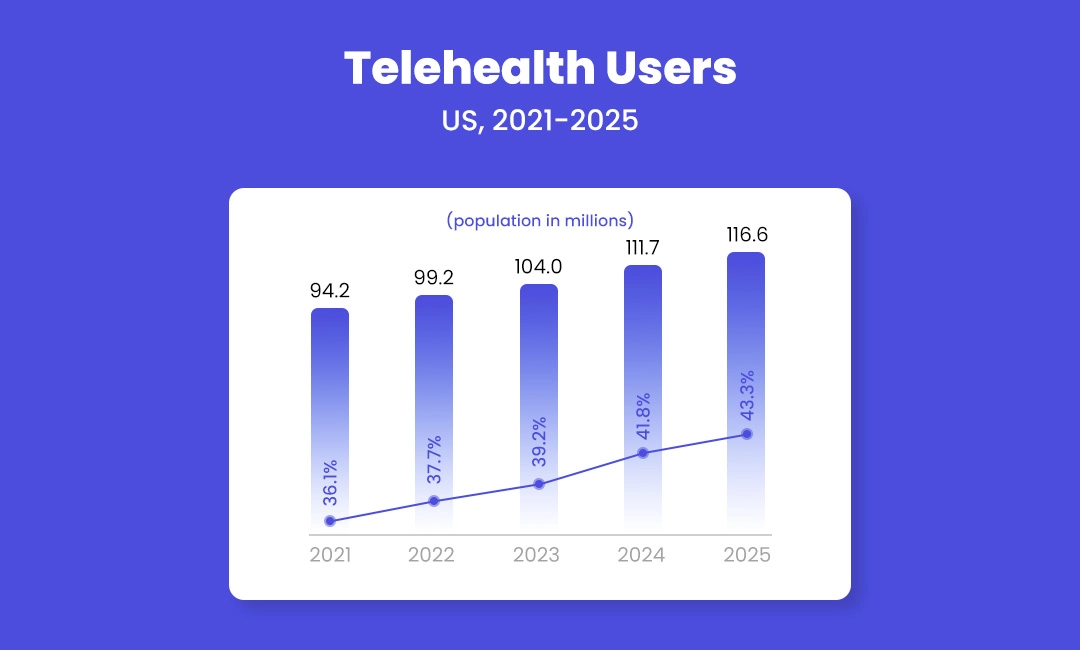
1. More than 43% of the US population will be permanently shifted to standard telehealth services.
2. In 2019, the telehealth market was valued at around $49.9 billion, and by the end of 2024, it will touch the mark of $194.1 billion.
3. In addition, this figure will cross the benchmark of $459.8 billion by the end of 2030.
On this note, let’s dive into how APIs can help healthcare providers adopt telemedicine solutions quickly and efficiently.
How Can APIs For Healthcare Apps Bring Robust Care?
Telehealth APIs provide healthcare providers the tools they need to quickly and easily develop an application tailored to their needs. These tools are designed with flexibility in mind, allowing providers to create custom solutions and streamline their workflows.
By using APIs, healthcare providers are able to securely access patient data, connect with EHRs (electronic health records), and integrate with external applications such as video calling software. This allows them to provide remote care that is not only convenient for their patients but also highly secure.
Furthermore, APIs remove the need for manual coding, enabling developers to quickly and easily create applications without spending time coding from scratch. This makes it much easier for healthcare providers to adopt telemedicine solutions, allowing them to focus on providing the best care possible.
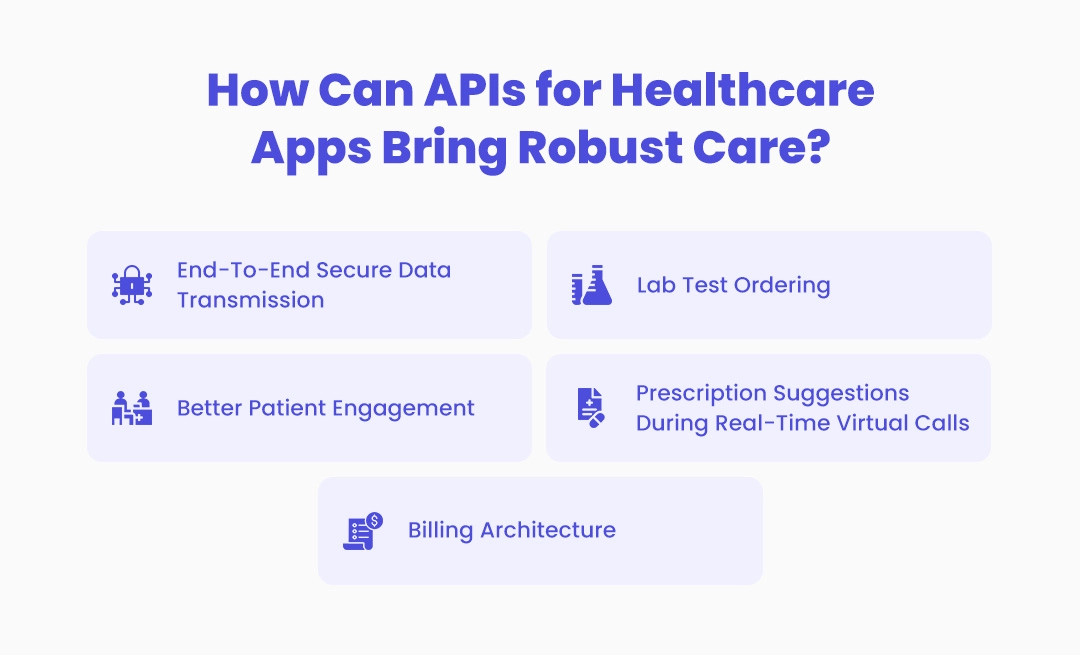
Along with these advancements, below are some advanced use cases of telehealth APIs:
End-To-End Secure Data Transmission
Telehealth APIs can help ensure the secure transmission of patient data between healthcare providers and other third parties, eliminating the risk of any potential data breaches. Moreover, patients can also be provided with access to their data through secure mobile applications.
Lab Test Ordering
Lab testing is a crucial element of healthcare, and telehealth APIs can facilitate the ordering, tracking, and reporting patient lab results. This allows healthcare providers to access the necessary data and provide an accurate diagnosis quickly.
Better Patient Engagement
Telehealth APIs enable healthcare providers to engage with their patients in a more meaningful way. By providing access to secure messaging, video conferencing, and other tools, healthcare providers can offer better care from any location.
Prescription Suggestions During Real-Time Virtual Calls
These APIs can also allow healthcare providers the ability to access patient data during a virtual call securely. This way, they can suggest the best treatment plan and provide prescription suggestions during a virtual call without needing a physical examination.
Billing Architecture
Telehealth APIs also provide an efficient billing architecture for healthcare providers, allowing them to track and manage payments easily. This helps streamline their workflows and improves their billing process. With multiple billing models supported, healthcare providers can choose the model that works best for their needs. On this note, let’s look at some practice use cases of telehealth APIs.
In-Demand Use Cases Of Telehealth APIs
There are several use cases that telemedicine software development companies are now focusing on. Post-COVID, telehealth APIs have become even more popular and in demand. These APIs are not only limited to providing remote care, but they also serve as powerful tools for healthcare providers to provide better health outcomes.
Some of the most in-demand use cases of healthcare APIs are:
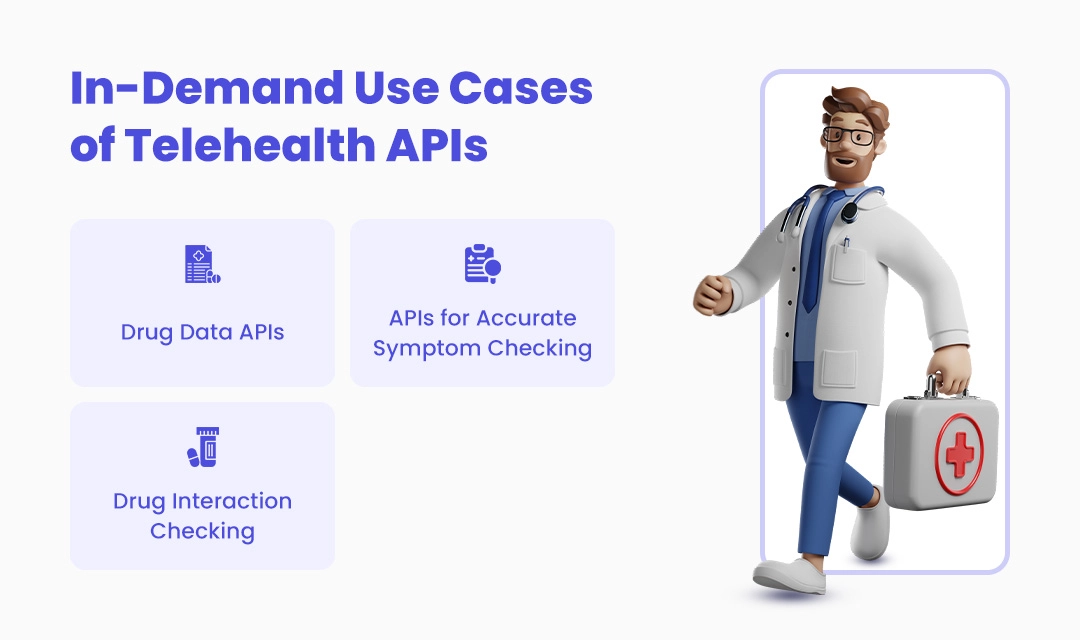
Drug Data APIs
Drug data APIs provide healthcare providers access to the latest drug information and research. This enables them to offer personalized treatments according to their patient’s needs.
Doctors can access data and updates from FDA and other sources, allowing them to make the best decisions for their patients.
Along with the latest medical datasets, doctors can also have access to a standard knowledge base and provide better assistance to their patients. The drug data APIs are ideal for delivering real-time information to healthcare providers and helping them identify customer needs.
APIs For Accurate Symptom Checking
Telehealth APIs can be used to check a patient’s symptoms and provide accurate diagnoses. As these APIs are integrated with EHRs, they can easily access patient data and suggest the best possible treatment plan.
Along with EHRs, healthcare providers can also integrate these APIs with chatbots, allowing them to quickly diagnose a patient’s condition. Moreover, these APIs can provide advanced features such as facial recognition and voice recognition, helping doctors make an accurate diagnosis.
Drug Interaction Checking
Healthcare institutes can integrate drug interaction APIs with their remote patient monitoring app to provide accurate drug interaction information. These APIs can be used to check for any potential interactions between drugs, helping healthcare providers make informed decisions and protect their patients from adverse drug reactions.
It will allow doctors to find errors in a patient’s medication regime and provide them with the necessary information to prevent any potential harm. In addition, these APIs can also be used to check for drug interactions and provide accurate dosage information, ensuring that their patients get the best care. If you’re planning to build a custom app and wondering about the available healthcare API options, here’s a list of some popular APIs.
Popular Healthcare APIs Available In The Market
DrChrono API
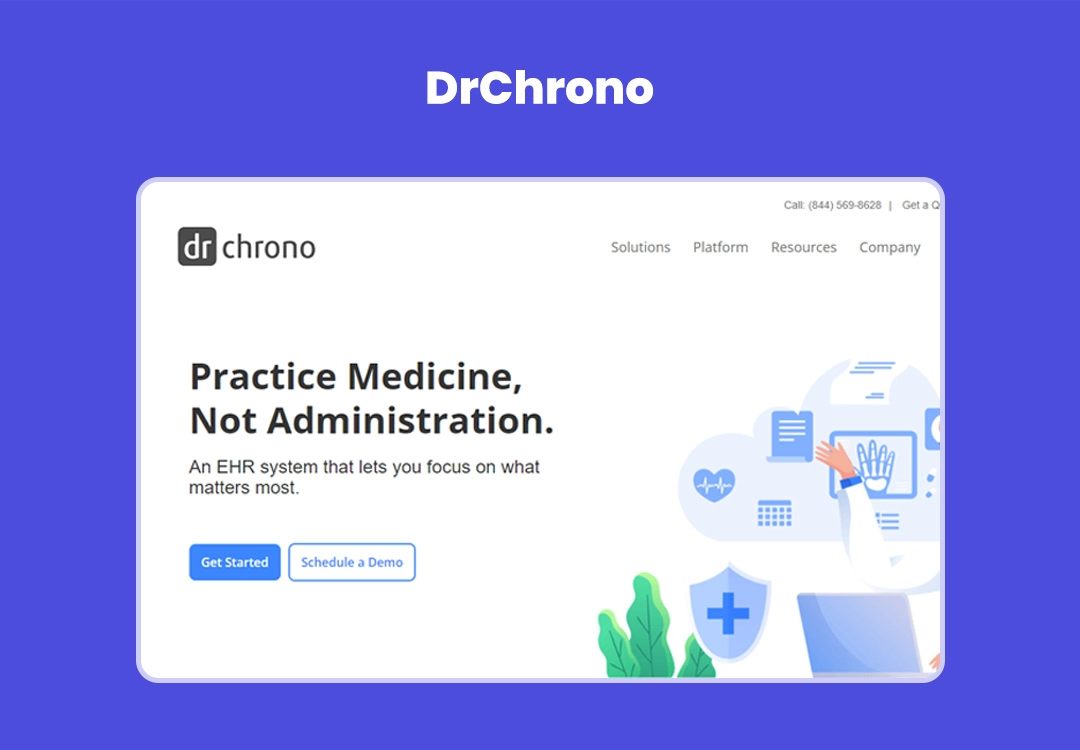
DrChrono is one of the popular APIs that help healthcare providers provide better remote care. This EHR system allow them to access patient data, create and modify appointments, retrieve vitals, lab orders, and more. It also supports multiple billing models that streamline its billing process. DrChrono is ideal for small clinics, and some of the critical features of DrChrono APIs are:
1. Vaccine Record Management: DrChrono APIs allow healthcare providers to track and manage vaccine records, which can be used to provide better preventative care. With this feature, doctors can quickly identify which vaccines are due and when they should be administrative.
2. Document Sharing: DrChrono APIs an easy way for healthcare providers to store, share and manage documents securely. This features allows doctor to quickly access patients information such as consent forms, payments, messages, and more.
3. Lab Orders Integration: Lab orders are used to collect samples for further testing and analysis. With DrChrono APIs, doctors can easily integrate lab orders with their EHR system, allowing them to order tests and track results with ease.
Health Gorilla APIs
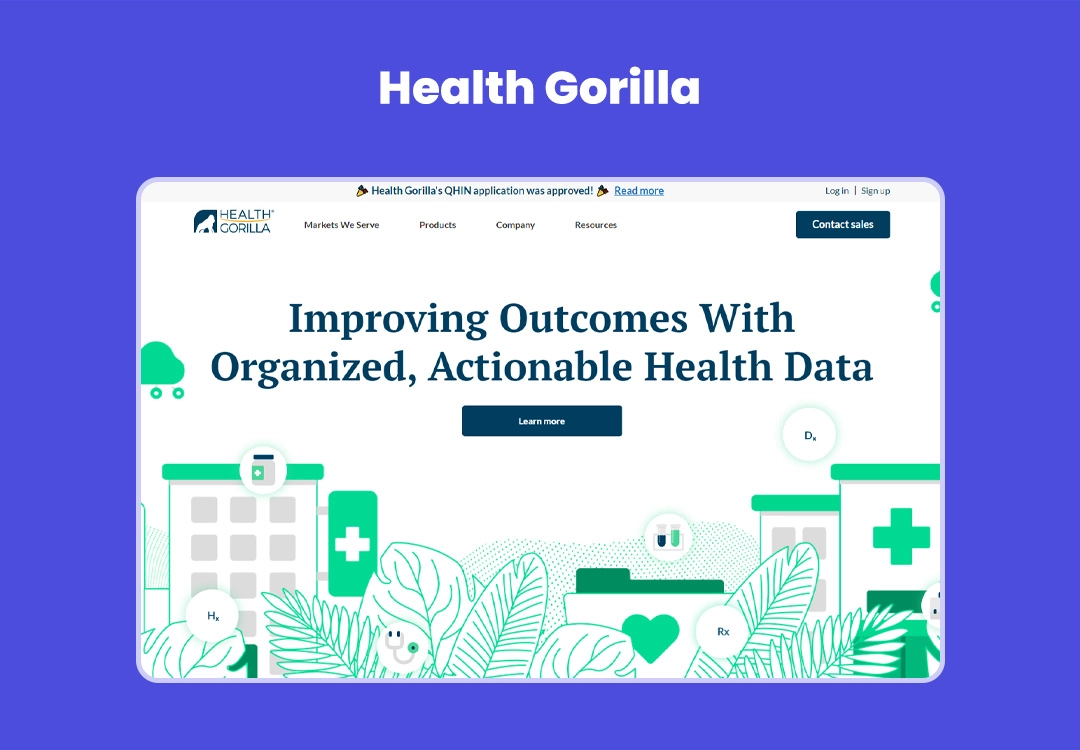
Health Gorilla allows healthcare providers to have a better clinical data exchange with a suite of FHIR-based APIs. This API provides instant access to a vast network of EHR systems and diagnostic labs, allowing doctors to access medical records and track patient health information quickly. Health Gorilla APIs are ideal for small and large-scale healthcare institutes and hospitals, and it offers features like:
1. Patient360 API: With this API, healthcare providers can access a patient’s medical history and other documents to provide better care. It allows doctors to quickly pull up relevant information on patients and make informed decisions.
2. Diagnostic Network API: This API enables healthcare providers to access a network of diagnostic laboratories and services, helping them get accurate test results quickly. Moreover, it also provides doctors with real-time information on patient tests, allowing them to make timely decisions.
3. eFax API: This API helps healthcare providers securely exchange documents and messages with patients, allowing them to communicate without compromising patient privacy or security.
4. Natural Language Processing API: This API helps healthcare providers extract meaningful information from medical documents and other texts, allowing them to access patient information and get insights quickly.
5. Identify Verification API: This API helps healthcare providers easily verify a patient’s identify and keep records safe from identify theft or fraud.
6. FHIR Store API: This API helps healthcare providers easily store, retrieve, and manage clinical data in a standardized format. It allows doctors to access patient information and use it for better care quickly.
Validic API
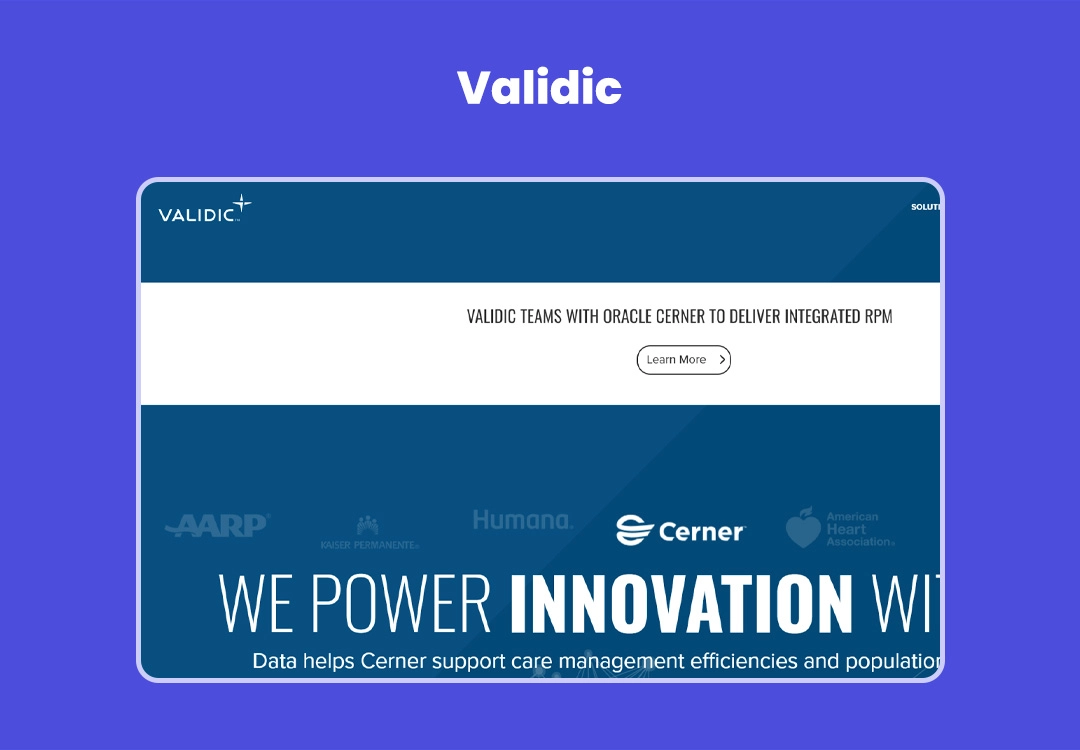
For supporting large-scale remote patient monitoring app development for healthcare providers and pharmaceuticals, Validic API offers a secure and reliable platform to convert data from wearables in a standardized format.
It allows healthcare providers to access real-time health data from more than 200 mHealth apps and devices. Moreover, it can collect data in a standardized format from various health-tracking apps, including Fitbit, Jawbone, and more. Some of the key features of the Validic API are:
Data Aggregation and Standardization: The Validic API allows healthcare providers to collect and aggregate data from wearables in a standard format. This helps them easily access real-time patient health information without have to worry about compatibility issues.
Connected Health Devices: The Validic API connects healthcare providers to over 200 mHealth apps and devices, allowing them to access patient health data in real-time. This helps doctors easily monitor patient conditions and provide better care.
Risk Scoring & Insights: The Validic API provides healthcare providers with risk scoring and personalized insights, allowing them to track patient health conditions more accurately. This helps doctors make informed decisions and provide better care.
Analytics & Reports: The Validic API also provides healthcare providers with analytics and reports, allowing doctors to track patient health trends and make timely decisions. This helps healthcare providers quickly access patient data and use it for better care.
Secure Connections: The Validic API offers secure connections between healthcare providers and mHealth apps, ensuring patient data privacy and security. This helps protect patient information from unauthorized access or misuse.
Bluestream API
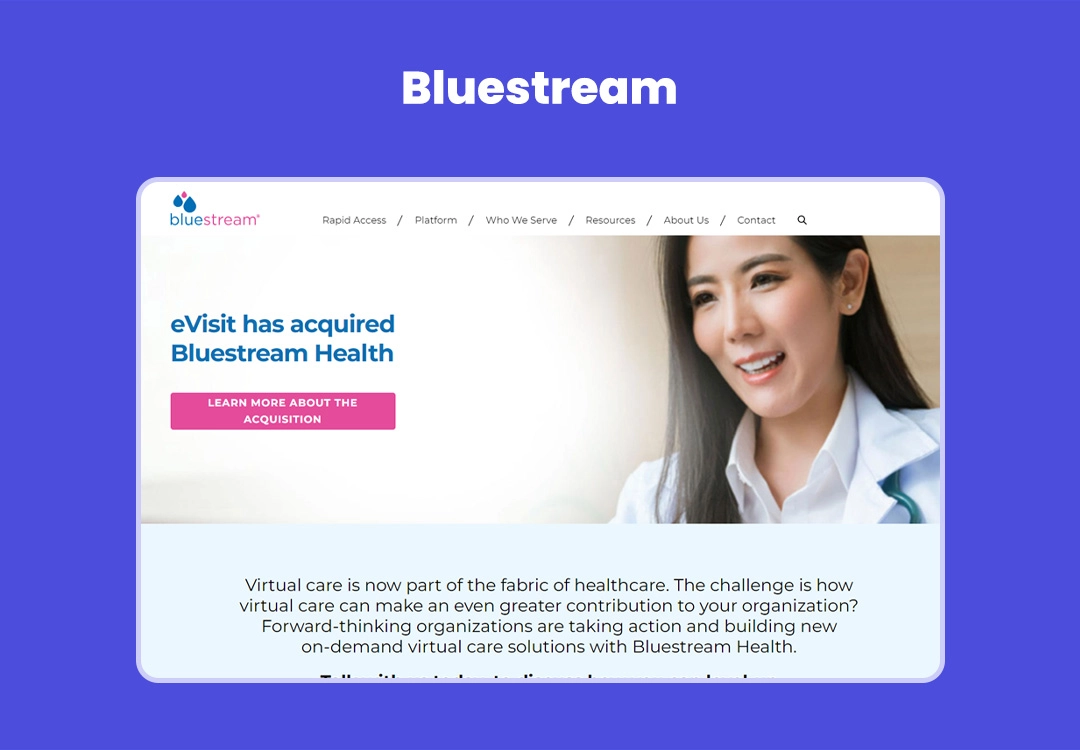
Bluestream API helps healthcare providers embed virtual visits into existing systems, allowing them to offer remote care without altering the workflow. It’s ideal for health systems and clinics of any size. This API offers end-to-end HIPAA-compliant solutions, as well as augmented functionality for existing software to run online video appointments. Some of the critical features of Bluestream API are:
Secure Video Visits: The Bluestream API allows healthcare providers to schedule and conduct secure video visits with patients. This helps doctors provide quality care while also keeping patient data secure.
Virtual Consultation Scheduling: The Bluestream API also helps healthcare providers easily schedule virtual consultations with patients. This allows doctors to keep track of their appointments and make timely decisions.
Queue Management & Tracking: The Bluestream API enables healthcare providers to manage and track calls in the queue, helping them monitor patient visits. This allows doctors to prioritize patients based on their needs and provide better care.
Real-time Activity Tracking: The Bluestream API also provides healthcare providers with real-time activity tracking for billing and reporting. Moreover, it allows them to access patient data and use it for better care quickly.
Current Challenges In The Healthcare API Landscape
The future of healthcare API is bright, but there are a few challenges that need to be addressed. As the healthcare industry directly deals with sensitive patient information, it is essential to ensure the security and privacy of the data.
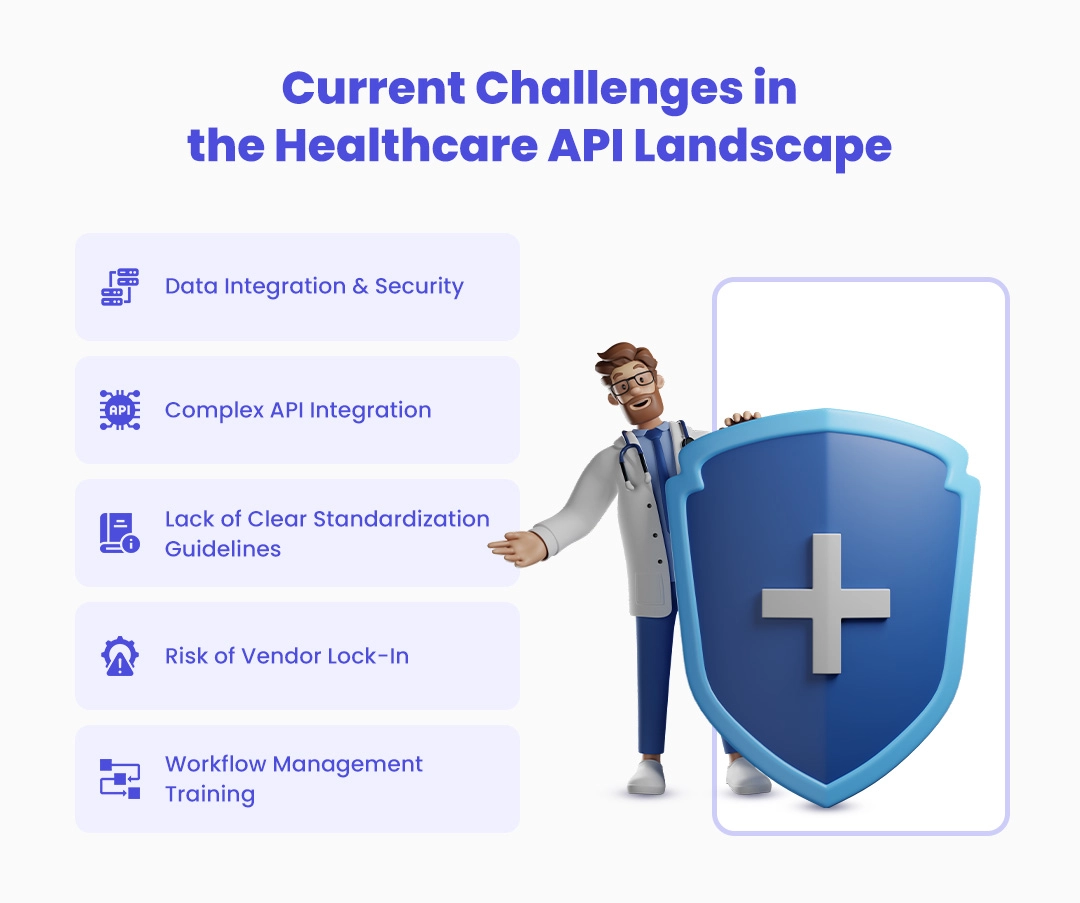
Let’s dive into some of the challenges that need to be addressed by healthcare solution providers:
Data Integration & Security
As healthcare API deals with sensitive patient information, it is essential to ensure the security and privacy of the data. Integrating healthcare APIs with existing systems can be tricky and requires advanced security measures to ensure that patient data is not compromised.
In addition, the compliance rules vary from region to region, and healthcare solution providers must ensure that their APIs are compliant with the relevant regulations. The lack of a global criterion for healthcare data also makes it harder for healthcare providers to manage and use patient data.
Complex API integration
Integrating healthcare APIs with existing systems can be complex, especially when it comes to legacy systems. As the majority of healthcare providers use legacy systems, it can be a challenge to integrate healthcare APIs with those systems. Moreover, additional testing and maintenance cost is also required to ensure that the integration is successful.
Moreover, the shift toward cloud-based healthcare infrastructure also poses a few challenges for healthcare providers. Many healthcare APIs are still built on legacy systems and require additional maintenance and development costs to migrate them to the cloud.
Lack Of Clear Standardization Guidelines
The lack of clear standardization guidelines also makes it difficult for healthcare providers to integrate APIs with existing systems. Moreover, the complexity of the protocols and standards used by healthcare API makes it difficult for healthcare providers to adopt new technology quickly.
For example, the FHIR protocol, which is widely used in healthcare API development, is still evolving, and health providers must ensure that their solutions are up to date with the latest version of the protocol.
Risk Of Vendor Lock-In
The risk of becoming locked into a particular healthcare API solution also exists. Healthcare providers must thoroughly research the features and pricing offered by the solution provider to ensure that they are not locked into a particular vendor.
Moreover, healthcare providers must also ensure that the solution they choose is scalable and can be integrated with existing systems. Additionally, it is essential to make sure that the solution provider is reliable and can provide timely support for any issues that may arise.
Workflow Management Training
As healthcare APIs become more popular, healthcare providers must also ensure that their staff is trained in workflow management. This includes training the staff on how to use and manage healthcare APIs, as well as how to monitor and access patient data effectively.
Additionally, healthcare providers must also ensure that their staff is aware of the compliance requirements related to healthcare data. This includes understanding the importance of patient privacy and security, as well as any applicable regulations regarding the use of healthcare data.
If you’re planning to integrate telehealth APIs with your remote patient monitoring app, it’s essential to hire a professional company like Auxano Global Services.
Why Hire Auxano Global Services For Telehealth API And App Development?
Auxano Global Services is a leading healthcare app development company that provides end-to-end solutions for creating remote patient monitoring apps, as well as healthcare APIs. Our team of experienced software engineers, data scientists, and healthcare experts can help you create efficient, secure, and robust telemedicine apps that are compliant with the latest regulations.
We have the expertise to develop and integrate healthcare APIs with existing systems, as well as cloud-based infrastructure. Additionally, our team can also help you with workflow management, HIPAA compliance, and user experience.
We understand the importance of patient privacy and security, which is why we use cutting-edge technologies to ensure that your patients’ data remains safe and secure. Contact us today for more information about our healthcare API development and remote patient monitoring solutions.
Wrapping Up!
Telehealth APIs are essential for creating efficient, secure, and robust remote patient monitoring apps. They enable healthcare providers to quickly access and manage patient data, as well as integrate APIs with existing systems.

However, healthcare providers must also ensure that their staff is adequately trained in workflow management and HIPAA compliance. It’s essential to hire an experienced software development company for telehealth API and app development to ensure that your solutions are compliant with the latest regulations.
Frequently Asked Questions
-
1. What Is Telehealth API?
Telehealth API is a set of protocols that allows healthcare providers to access and manage patient data, as well as integrate APIs with existing systems. Moreover, using telehealth API also enables healthcare providers to provide remote patient care.
-
2. How Can Telehealth API Help Healthcare Providers?
Telehealth API enables healthcare providers to access and manage patient data, as well as integrate APIs with existing systems. This enables healthcare institutes to provide remote patient care and seamless monitoring.
-
3. Can We Integrate Healthcare APIs With Existing Systems?
Yes, you can integrate healthcare APIs with existing systems to create secure remote patient monitoring apps. In addition, you can also use healthcare APIs to create custom applications for specific needs.
-
4. How Will These APIs Help To Ensure Patient Privacy?
Healthcare APIs use cutting-edge technologies and are compliant with HIPAA regulations to ensure patient privacy and security. Moreover, technology providers are constantly working towards making their APIs secure and compliant.
-
5. Why Should Small Clinics And Hospitals Use Telehealth APIs?
Telehealth APIs are cost-effective and enable healthcare providers to ensure a better quality of care. Moreover, they also allow healthcare providers to assist patients in a timely manner and reduce the need for in-person visits.



